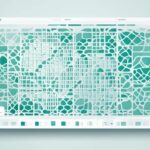Table of Contents
In today’s digital landscape, responsive web design has become a crucial aspect of creating successful websites. With the increasing variety of devices and screen sizes that users utilize to access the internet, it’s essential to ensure that websites can adapt and provide a seamless experience on any device. This is where the power of CSS Grid and Flexbox comes into play.
CSS Grid simplifies the process of creating grid-based layouts, allowing web designers to create dynamic and responsive designs. By defining columns and rows, designers can easily organize content and tailor it to different screen sizes. With CSS Grid, the possibilities are endless, giving designers the flexibility they need to create visually appealing and functional layouts.
On the other hand, Flexbox provides a more efficient way to align and distribute space among items in a container. With Flexbox, designers can easily create responsive navigation bars and other flexible elements, ensuring that the website’s layout adapts seamlessly to different screen sizes.
By leveraging the power of Flexbox and CSS Grid, web designers can achieve responsive web design that not only looks great but also functions flawlessly on devices of all sizes. Whether it’s creating a responsive navigation bar or designing complex grid layouts, these modern CSS techniques provide the tools needed to create responsive and user-friendly websites.
Through this article, we will delve deeper into the fundamentals of responsive design, explore how to build responsive layouts using Flexbox and CSS Grid, and provide valuable tips and techniques to enhance your responsive web design skills.
Stay tuned for the next section where we will dive into the fundamentals of responsive design and explore the core principles that make it all possible.
Fundamentals of Responsive Design
Responsive web design is built upon core principles that enable websites to function effectively across a range of devices. By employing fluid layouts, flexible images, and adhering to the core principles of responsive web design, seamless user experiences can be achieved on any screen size or device.
Fluid Layouts
One of the core principles of responsive design is the use of fluid layouts. Fluid layouts utilize relative units like percentages to allow elements on a webpage to resize proportionally based on the screen size. This ensures that content remains readable and accessible regardless of the device being used.
By employing fluid layouts, web designers can create dynamic webpages that adapt seamlessly to different screen sizes and orientations. This flexible approach eliminates the need for multiple versions of a website specifically tailored to various devices, resulting in a more efficient development process and improved user experience.
Flexible Images
In addition to fluid layouts, responsive design incorporates the use of flexible images. Flexible images can scale up or down without distortion, maintaining their aspect ratio across different screen sizes. This ensures that images remain visually appealing and do not negatively impact the overall design and layout of a webpage.
By using responsive image techniques, web designers can enhance the visual experience for all users, regardless of the device or screen resolution. This results in a more engaging and immersive web experience, improving user satisfaction and retention.
Core Principles of Responsive Web Design
These principles serve as the foundation of responsive web design, enabling website layouts to adapt to different devices seamlessly:
- Fluid layouts using relative units like percentages
- Flexible images that scale without distortion
- Media queries to target specific screen sizes and apply custom styles
- Mobile-first approach, ensuring optimal experiences on smaller screens
By following these core principles, web designers create websites that prioritize accessibility, user experience, and visual consistency across devices, ultimately enhancing the overall effectiveness and impact of their websites.
“Responsive web design is not just about adjustable screen resolutions and automatically resizing images. It is a philosophy that embraces flexibility and adaptation, providing users with optimal experiences regardless of the device they choose to browse the web on.”
Understanding the fundamentals of responsive design is essential for any web designer or developer striving to create modern and user-friendly websites. By utilizing fluid layouts, flexible images, and adhering to the core principles of responsive web design, web professionals can ensure their creations offer seamless experiences across devices, delighting users and delivering tangible business results.
Building a Responsive Layout with Flexbox
Flexbox is a powerful one-dimensional layout method that enables the precise alignment and distribution of space among elements in a container. It is particularly useful in creating responsive navigation bars that adapt seamlessly to different screen sizes. By employing the display property set to flex and applying appropriate CSS properties, designers can easily build a responsive navigation bar that adjusts its layout based on the available screen space. Flexbox provides a flexible and efficient solution for creating enticing and adaptable responsive layouts.
When using Flexbox to build a responsive navigation bar, the first step is to set the parent container’s display property to flex:
display: flex;
This establishes the container as a flex container, allowing its child elements to be aligned and distributed within it. It’s important to note that the child elements (navigation items) should be direct descendants of the flex container.
Once the parent container is configured, designers can utilize a range of Flexbox properties to achieve the desired responsive layout. Some commonly used properties include:
flex-direction: Determines the direction in which the child elements are displayed (horizontal or vertical).justify-content: Controls how space is distributed along the main axis (horizontal axis for flex-direction: row and vertical axis for flex-direction: column).align-items: Specifies how the child elements are aligned along the cross axis.flex-wrap: Determines whether child elements should wrap to multiple lines when there is limited space.
By strategically combining these properties and applying appropriate values, designers can create a responsive navigation bar that adapts gracefully to various screen sizes. The following code snippet demonstrates an example of a responsive navigation bar built using Flexbox:
<nav class="flex-container">
<a href="#" class="navigation-item">Home</a>
<a href="#" class="navigation-item">About</a>
<a href="#" class="navigation-item">Products</a>
<a href="#" class="navigation-item">Contact</a>
</nav>
And the accompanying CSS:
.flex-container {
display: flex;
justify-content: space-between;
align-items: center;
}
.navigation-item {
margin-right: 1rem;
color: #555;
text-decoration: none;
}
The above code creates a navigation bar with a flexible layout that evenly distributes the navigation items and adjusts according to the available space. The justify-content property is set to space-between, which places equal space between each navigation item. The align-items property centers the navigation items vertically within the flex container.
With Flexbox, designers have a powerful tool at their disposal for building responsive layouts. Whether it’s a navigation bar, card layout, or any other component, Flexbox’s flexibility and adaptability make it an ideal choice for creating intuitive and appealing responsive designs.
Creating a Responsive Layout with CSS Grid
In the realm of responsive web design, a key player that enables the creation of grid-based layouts with ease is CSS Grid. This two-dimensional layout system provides web designers with the tools they need to develop responsive grid layouts that adapt beautifully to various devices and screen sizes.
When working with CSS Grid, the first step is to define a grid container, which acts as the parent element that holds the grid items. By applying the display: grid; property to the container, we establish a grid context within which the layout will be constructed.
Grid items, on the other hand, are the individual elements that will be laid out within the grid container. These elements are direct children of the grid container and can be any HTML element, such as divs, sections, or even images.
The power of CSS Grid lies in the ability to control the structure of the grid using CSS properties such as grid-template-columns and grid-template-rows. These properties allow us to define the number and size of the columns and rows in our grid layout, providing precise control over the positioning and sizing of the grid items.
To enhance the visual appeal of the grid layout, we can also utilize the grid-gap property. This property sets the spacing between grid cells, creating well-defined gaps between the elements in the grid.
By combining these CSS properties, web designers can create responsive grid layouts that adapt effortlessly to different screen sizes. Whether you’re designing a portfolio website or an e-commerce store, CSS Grid offers a flexible and efficient solution for achieving a responsive design. With the ability to define complex grid structures and precisely position grid items, CSS Grid empowers designers to create visually stunning and highly functional websites.
“CSS Grid provides a flexible and efficient way to create responsive designs.”
– Web Design Weekly
Conclusion
With the help of CSS Grid and Flexbox, responsive web design has become more accessible and efficient. These modern CSS techniques provide powerful tools for web designers to create adaptable layouts that cater to various screen sizes and devices. By incorporating the principles of responsive design and utilizing the features of CSS Grid and Flexbox, designers can craft visually appealing and functional websites.
However, it’s crucial to be mindful of performance when using these techniques. While CSS Grid and Flexbox offer flexibility and ease of use, it’s important to optimize the website’s performance to ensure fast loading times. Additionally, web designers must consider fallback strategies for older browsers that may not fully support these CSS technologies.
CSS Grid and Flexbox have transformed layout design and have become essential tools for responsive web design. By leveraging their capabilities, designers can create responsive layouts that adapt seamlessly to different devices, providing users with an optimal browsing experience. Whether it’s creating a responsive navigation bar with Flexbox or designing a grid-based layout with CSS Grid, these techniques empower designers to build websites that are visually appealing and user-friendly across all platforms and devices.
FAQ
What is responsive web design?
Responsive web design is a design approach that ensures websites work well on any device, from smartphones to large desktop monitors. It involves creating layouts that adapt and resize based on the screen size of the device.
How does responsive web design work?
Responsive web design works by utilizing fluid layouts, which use relative units like percentages to allow elements to resize relative to the screen size. It also involves using flexible images that can scale up or down without distortion.
What is CSS Grid?
CSS Grid is a two-dimensional layout system that allows for the creation of responsive grid-based layouts. It involves defining a grid container and grid items, and using CSS properties like grid-template-columns and grid-template-rows to control the columns and rows of the grid.
What is Flexbox?
Flexbox is a one-dimensional layout method that excels at aligning and distributing space among elements in a container. It is commonly used to create responsive navigation bars and provides a more efficient way to align and distribute space among items.
To create a responsive navigation bar using Flexbox, you can set the display property to flex and apply appropriate CSS properties. This allows the navigation bar to adjust based on the screen size, providing a responsive layout.
How can I create a responsive grid layout using CSS Grid?
To create a responsive grid layout using CSS Grid, you need to define a grid container and grid items. CSS properties like grid-template-columns and grid-template-rows control the columns and rows of the grid, while grid-gap sets the spacing between grid cells.













